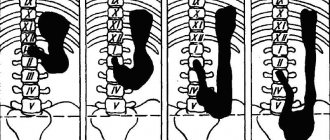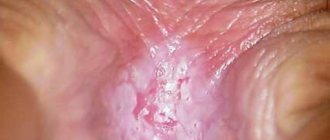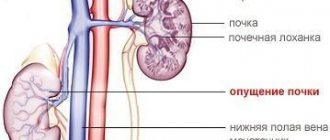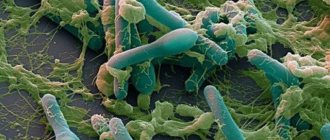Home » Intestinal dysbiosis
Intestinal dysbiosis is a common pathology that is associated with disorders of the gastrointestinal tract. Many medical experts argue that this is not a disease, but intestinal dysfunction, which is the result of pathology or poor lifestyle. Symptoms of intestinal dysbiosis in adults have different intensity, frequency, and character. If left untreated, it leads to serious complications and consequences.
With normal microflora and undisturbed peristalsis, the large intestine contains a small number of microbes that should be in the body of every person. Microorganisms and bacteria perform important functions for the human body.
What is intestinal dysbiosis in adults?
Dysbacteriosis is the opposite state of normbiocenosis. Intestinal activity decreases and food processing takes much longer. Microflora and intestinal motility worsen. Opportunistic bacteria appear in the human body, which disrupt the functioning of internal organs.
A lack of lactobacilli and necessary microorganisms leads to disruption of intestinal function. The digestion process worsens, metabolism slows down, and immunity decreases. There is a lack of nutritional components in the body. The digestive tract becomes weakened and reacts to environmental influences.
The human intestine contains beneficial and pathogenic bacteria. The average weight of the first group is two kilograms. There are more than five hundred varieties of such microorganisms. The following components are considered the most common:
- bifidobacteria;
- lactobacilli;
- coli.
Pathogenic bacteria include:
- peptococci;
- Candida mushrooms;
- staphylococci;
- clostridia.
There are not as many harmful bacteria released as beneficial ones. In a healthy person, bacteria are located in the body and do not manifest themselves, since the body has a strong immune system. If the immune system weakens, then certain symptoms appear.
Necessary microorganisms are responsible for the synthesis of vitamins, for lowering cholesterol levels, for processing food and absorption into the intestinal walls. Metabolism occurs.
Causes of intestinal dysbiosis in adults
The causes of intestinal dysbiosis have different etiologies. Disturbed microflora is always caused by certain factors. The reasons that influence the appearance of dysbiosis are as follows:
- deficiency of enzymes responsible for food processing;
- weakness of the intestinal muscles that must process food;
- increased acidity or alkali level in internal organs;
- deficiency of substances that promote the growth of essential bacteria;
- excessive number of parasites in the intestines.
You can cure an intestinal disease only if you are sure of the cause that influenced the appearance of the pathology. The above factors may be caused by the following reasons:
- diseases of the gastrointestinal tract, such as gastritis, duodenal ulcer, colitis;
- viral, fungal, parasitic infections;
- congenital or acquired structural disorders of the gastrointestinal tract;
- a disrupted diet consisting of fried and fatty foods;
- genetic predisposition
- environmental damage, environmental situation in the region;
- excessive physical activity, especially in men;
- excessive consumption of alcoholic beverages, which kill microflora;
- long-term use of antibiotics and other medications;
- nervous tension (this factor is common among females);
- pregnancy or hormonal imbalances;
- fasting or sudden change of diet;
- reduced immunity;
Allergic reactions can also provoke intestinal dysbiosis. Very often, the disease occurs in people who are associated with climate change and often travel. The body needs to adapt and get used to a different climate zone.
Vaginal dysbiosis in girls
Disorders of the vaginal microflora occur in girls who have not begun sexual activity with approximately the same frequency as in women who are sexually active. This is due to several other factors - hormonal instability, the formation of a cycle, as well as the anatomical features of the structure of the hymen.
Vaginal dysbiosis in girls rarely manifests itself as heavy discharge, since the openings of the hymen, as a rule, do not allow them to be removed from the vagina in the quantity in which they are formed. Therefore, stagnation of vaginal discharge develops, and the likelihood of developing inflammatory diseases in virgins is higher. On the other hand, when sexual activity begins with the first sexual intercourse, a large number of bacteria are thrown from the vagina into the bladder, and this can lead to the so-called “honeymoon cystitis”.
Treatment of vaginal dysbiosis in virgin girls is somewhat difficult due to the fact that the structure of the hymen does not always allow for proper treatment of the vagina with medications. In some cases, it is even necessary to resort to artificial disruption of the integrity of the hymen - hymenectomy.
At SM-Clinic, gynecologists, after conducting examinations and tests, will identify the exact causes of vaginal dysbiosis and prescribe effective comprehensive treatment that will lead to the restoration of normal vaginal microflora.
Types of dysbacteriosis
The following types of dysfunction are distinguished:
- chronic dysbacteriosis;
- acute dysbacteriosis;
The acute variety occurs in most cases and is considered the most common. With timely diagnosis and treatment, unpleasant symptoms disappear within a few days after the start of treatment therapy.
The chronic type of dysbiosis is diagnosed much less frequently. Dysfunction manifests itself if the acute type was not diagnosed and treated on time. Also, the acute stage becomes chronic if the patient abuses alcohol or leads an unhealthy lifestyle.
Dysbacteriosis is divided according to the type of pathogen. Highlight:
- proteaceae,
- staphylococcal,
- associative,
- and fungal species.
The easiest way to cure Proteus dysbiosis. Associative dysfunction is considered dangerous; the period of treatment and rehabilitation is long.
To determine the type of dysbiosis, it is worth visiting a medical specialist. In the private proctology clinic “Proctologist 81”, diagnostic studies are carried out using modern equipment.
Main methods of treatment
In order for the treatment of dysbiosis to bear fruit, it is first necessary to identify and eliminate the cause that provoked its appearance. Therapeutic manipulations should be carried out in combination:
- diet;
- elimination of pathogenic microflora;
- colonization of the intestines with “good” microorganisms;
- strengthening the body (vitamins, immunostimulants).
Diet features
In case of dysbacteriosis, heavy foods are excluded.
For dysbiosis, a nutritious diet is recommended, enriching the body with a full range of essential substances. Heavy foods are excluded. Alcohol, sweets, animal fats, legumes, spicy and carbonated foods are prohibited.
At the same time, it is necessary to increase the amount of low-fat fermented milk products in the diet.
Stages of dysbiosis
Intestinal dysfunction has several stages. Depending on the stage, the patient is prescribed treatment. The following stages of development of intestinal dysbiosis are distinguished:
| Dysbacteriosis of the first degree | At the initial stage, the amount of E. coli, namely Escherichia, decreases in the human body. There are no symptoms, no deficiency of lactobacilli is observed. |
| Dysbacteriosis of the second degree | The number of Escherichia in the body is rapidly decreasing. A deficiency of bifidobacteria and other beneficial microorganisms that are responsible for metabolism and the digestive process is diagnosed. The number of pathogenic bacteria increases. |
| Dysbacteriosis of the third degree | There is a severe shortage of bifidobacteria and lactobacilli. The patient feels a lot of discomfort and problems with bowel movements appear. Intestinal function is disrupted, microflora and peristalsis are disrupted. |
| Dysbacteriosis of the fourth degree | Bifidoflora in the intestines is in a terrible state. Lactobacilli are completely absent. Dangerous destructive processes occur in the intestines, peristalsis is completely disrupted. |
To avoid complications and negative consequences, treatment should be started at the initial stage.
Drugs and their action
The most effective way to restore microflora and get rid of dysbiosis is to use drugs from the group of probiotics. Manufacturers offer medicines in different forms:
- capsules;
- pills;
- powder;
- drops;
- solution.
The dosage form is selected by the doctor depending on the age of the patient. Children and elderly people who have difficulty swallowing tablets are prescribed a solution or powder for its preparation. At the age of 0-3 years, it is easier to give probiotic drops to a child. For everyone else, capsules or tablets are recommended.
Anti-dysbacteriosis medications are medications that can be purchased without a doctor's prescription. But self-medication is not recommended; only a specialist can tell you which type is best to take.
Probiotics usually contain 1-2 types of bacteria that restore mucous membranes well. Usually these are lacto- and bifidobacteria. They are normal inhabitants of the intestines that help improve microbial balance. The mechanism of action of this therapeutic group is associated with suppression of the growth of pathogenic flora. Lactic acid bacteria compete for receptors on the mucosal epithelium and nutrients. They secrete lactic acid and cytokines, which have an inhibitory effect on pathogens.
Preparations from the group of prebiotics help to effectively cure dysbiosis. These are medications that belong to the group of dietary fibers: inulin and lactulose, as well as drugs based on them.
They are not broken down by digestive enzymes and enter unchanged into the large intestine, where they become a nutrient substrate for lacto- and bifidobacteria. Therefore, microbes multiply well, increase the volume of bacterial mass, and restore the intestinal wall. To make the treatment as effective as possible, it is recommended to take prebiotics and probiotics at the same time.
Treatment of dysbiosis is not contraindicated in case of concomitant pathologies of the digestive tract. Probiotics are not harmful to patients with stomach ulcers, liver disease, or gallbladder disease. And in some cases they will speed up recovery.
In advanced cases of intestinal dysbiosis and when the symptoms of dyspepsia are too painful, medications from the group of enzymes can help. They should be selected by a doctor, depending on the type of digestive disorder. These medications must be taken daily before meals.
It’s hard to say how long it will take to treat dysbacteriosis. In some cases, this can last for several weeks, and in advanced cases – several months.
Signs of intestinal dysbiosis in an adult
At the second stage, symptoms appear that indicate intestinal dysbiosis. There are no specific symptoms, so patients often confuse intestinal dysfunction with other pathologies.
- bad breath;
Putrefactive processes occur in the body. These processes are caused by the accumulation of harmful components in the intestinal tract.
- gastrointestinal disorders;
The patient is worried about diarrhea. The walls of the anus are injured, the mucous membrane is irritated, which leads to the formation of anal fissures. Diarrhea occurs up to ten times a day, regardless of food intake. Often, stool has a foamy structure in appearance.
Constipation is also observed with dysbacteriosis, but much less frequently. Fecal masses collect in the intestines, so the patient develops colicky pain and the stomach swells. Constipation is observed in older people whose peristalsis is noticeably impaired.
- bowel dysfunction;
The stool is disrupted, with constipation alternating with diarrhea. Bloody impurities, mucus and even pus are found in the stool. This symptom indicates an inflammatory or infectious process. The color of the stool becomes greenish. After eating, rumbling appears in the stomach. We are talking about problems in the intestines. Flatulence increases. Excessive gas formation brings discomfort to the patient. Belching is observed.
- painful sensations;
Pain appears in the intestines. Unpleasant sensations intensify with constipation and pushing. Nausea and vomiting, itching and burning in the anus, and heartburn appear. With dysbacteriosis, food is slowly absorbed, so the patient rapidly loses weight and becomes constantly tired and sleepy. The patient becomes tense and nervous.
It is extremely rare for the temperature to rise to 38 degrees. The symptom indicates severe intoxication of the body. After eating food, an allergic reaction occurs, a skin rash and itching appears.
- avitaminosis.
The condition of bones, hair and nails deteriorates. Skin color becomes pale.
General concept of dysbacteriosis Dysbacteriosis is a violation of the composition and properties of microflora. It can occur anywhere: in the nasopharynx, in the intestines, and in the vagina. But intestinal dysbiosis is diagnosed much more often than all other types of dysbiosis combined. It is not surprising that when often using the word “dysbacteriosis,” both doctors and patients almost always mean intestinal dysbiosis. The intestines are home to various beneficial bacteria that ensure the normal functioning of our body: lactic acid bacteria, E. coli, various types of cocci and many others. The consistency of the composition of this microflora is very important for maintaining good health. With its help, a protective function is carried out in case of ingress of microbes contained in poor-quality food, dirty vegetables and fruits; immune, which stimulates the production of antibodies, increasing human immunity; synthesis of essential vitamins for humans (for example, vitamin K, which plays an important role in the blood coagulation system). However, when, due to various reasons, which will be discussed later, disturbances in the intestinal microflora occur, “dysbacteriosis” develops. Causes of dysbacteriosis
The most common cause of dysbiosis is treatment with antibacterial drugs (antibiotics, sulfonamides, etc.). After all, it is absolutely obvious that it is almost impossible to kill “bad” microbes while leaving the “good” ones intact. However, not only antibiotics are the “culprits” of dysbiosis. By and large, any drugs and any methods of therapy that suppress the immune system contribute to the development of dysbiosis (corticosteroid hormones, radiation therapy, the use of drugs that suppress tumor growth, etc.). Another cause of dysbiosis is nutritional disorders. This includes monotonous food, various abuses (fatty, sweet), and the population’s craving for self-experimentation (fasting, urine therapy, kefir diet, apple days, banana weeks). Diseases such as gastritis, duodenitis, ulcers, pancreatitis, and colitis also cause the occurrence of dysbacteriosis. It is also quite natural that any surgical intervention on the organs of the digestive system can lead to dysbacteriosis. Infectious diseases and the presence of parasites are also among the causative factors for the appearance of intestinal dysbiosis. In children of the first year of life, dysbiosis may be a consequence of unreasonably early introduction of complementary foods. Manifestations of dysbacteriosis
The main manifestations of dysbiosis include the following: gastrointestinal dyspepsia syndrome: problems with stool, usually diarrhea, but there may also be constipation. Patients also complain of rumbling in the stomach, bloating, unpleasant taste in the mouth, belching, nausea, and heartburn. Pain syndrome: abdominal pain of various types. Allergic syndrome. It manifests itself in almost all patients with dysbacteriosis. As a rule, it is expressed in the fact that a person cannot tolerate certain foods. Soon after eating such foods, patients experience nausea, loose stools, bloating, and allergic reactions: hives, itching, swelling. Syndrome of impaired intestinal absorption. It is characterized, firstly, by persistent diarrhea, and secondly, by signs obvious for specific disorders. And if the processes of malabsorption last a long time, then the general signs of human ill health are clearly indicated: immunity decreases, against the background of which frequent diseases of the nasopharynx, bronchi, lungs, skin, and joints begin. The syndrome of impaired intestinal absorption is directly related to another one - vitamin deficiency syndrome. Anorectal syndrome. It most often develops in people during long-term treatment with antibiotics. It is preceded by general poor health: weakness, headache, lack of appetite. Then the temperature may rise, diarrhea and dull pain in the anorectal area begin. What danger does “simple” dysbiosis pose? With dysbacteriosis, pathogenic microflora “blooms”, and the nutrients and microelements necessary for the body are poorly (or completely) absorbed. A huge amount of toxic substances accumulate in the intestines, which, when absorbed into the blood, affect all organs and tissues. Effective synthesis of vitamin D in the body, antiviral and antitumor protection are reduced, and local immunity is impaired. As a result, the “simplest” intestinal dysbiosis can be the root cause of damage to organs and tissues and cause many diseases, for example, pancreatitis, diabetes, fatty hepatosis, cirrhosis, cholelithiasis. Intestinal dysbiosis can also lead to eczema, psoriasis, atopic dermatitis, bronchial asthma, food and polyvalent allergies, immunodeficiency, changes in blood composition, diseases of the thyroid gland, central nervous system and even mental illness! Diagnosis and treatment The most common diagnostic method is bacteriological culture of stool for dysbacteriosis. With its help, it is possible to evaluate a fairly wide range of opportunistic microorganisms and identify a deficiency of bifidobacteria and lactobacilli. A scatological study (coprogram) is also carried out - a biological study of intestinal contents. How to decipher the dysbacteriosis test form? Bifidobacteria. The main representatives of normal intestinal microflora, the number of which in the intestine should be 95 - 99%. A significant decrease in the number of bifidobacteria is always a sign of severe dysbacteriosis. Escherichia coli with normal enzymatic activity (Escherichia). The amount of E. coli among other bacteria does not exceed 1%, but its role is very important, since this microbe: firstly, is the main competitor of opportunistic flora, preventing the colonization of the intestinal wall by foreign microbes; secondly, E. coli takes oxygen from the intestinal lumen, which is a poison for bifidobacteria and lactobacilli, thus creating comfortable conditions for the main bacteria of the intestinal flora. A decrease in the total amount of E. coli may be a sign of the presence of non-bacterial parasites in the intestines (worms, protozoa, which also require oxygen, depriving E. coli of it). Hemolyzing Escherichia coli. Normally it should be absent. It can cause allergic and intestinal problems, is very common in the environment (though it is almost never found in breast milk), causes problems in weakened children, and requires immunocorrection. It should be noted that the term “hemolyzing” does not mean that there is any effect on the blood. Conditionally pathogenic flora in case of dysbacteriosis should not overcome the intestinal wall and enter the blood. This is possible only with extremely pronounced forms of dysbiosis in children with severe immunodeficiencies, which, as a rule, pose a threat to life. Fortunately, such conditions are rare.
Coccal forms in the total amount of microbes. The most harmless representatives of opportunistic flora are enterococci. They are most often found in the intestines of healthy people, their amount up to 25% does not pose a threat to health. If the amount exceeds 25%, it is most often due to a decrease in normal flora. In rare cases, an increase in the number of enterococci is the main cause of dysfunction associated with dysbiosis. Staphylococcus aureus (S. aureus). One of the most unpleasant (along with hemolyzing Escherichia coli, Proteus and Klebsiella) representatives of opportunistic flora. Even small amounts of it can cause pronounced clinical manifestations, especially in children in the first months of life. Therefore, usually the standards given in the analysis form indicate that it should not exist. The pathogenicity of Staphylococcus aureus directly depends on the state of the normal flora: the more bifidobacteria, lactobacilli and normal Escherichia coli, the less harm from staphylococcus. Its presence in the intestines can lead to allergic reactions, pustular skin rashes, and intestinal dysfunction. Staphylococci are common environmental microbes, in particular they live in large quantities on the skin and mucous membranes of the upper respiratory tract. The baby can get them through breast milk. Weak children are most susceptible to infection with staphylococci (problem pregnancy, prematurity, cesarean section, artificial feeding, use of antibiotics - risk factors for weakening the functions of the immune system). Lactose-negative enterobacteria. A large group of opportunistic bacteria of greater or lesser degree of pathogenicity. Their number should not exceed 5%. The most unpleasant bacteria from this group are Proteus (most often associated with constipation) and Klebsiella (they are direct antagonists (competitors) of lactobacilli, which leads to the development of allergies and constipation, as well as manifestations of lactase deficiency). Often the analysis form indicates the total number of lactose-negative enterobacteria. Fungi of the genus Candida. The presence of up to 104 is acceptable. An increase in this parameter may occur after the use of antibiotics. If the number of fungi is increased, and the amount of normal intestinal flora is sharply reduced, and candidiasis (thrush) of the visible mucous membranes (oral cavity, genitals) is noted - these are manifestations of systemic candidiasis, that is, there is an infection with intestinal fungi.
Treatment of dysbacteriosis is not an easy task; it requires sufficient qualifications from the doctor and patience from the patient. A specific diet and pharmacological agents are used as components of therapy. The choice of diet and medications is determined by the specific variant of the disease, which is specified by the cause, complaints and symptoms, and tests. The main, but far from the only method of treatment is to find out which bacteria are missing and to compensate for the deficiency with the help of so-called eubiotics - medicines that are dried and specially treated intestinal microbes. Once in the intestines, these microbes come to life and begin to do their job. Enzymes (festal, mezim, enzistal, panzinorm, etc.) and vitamins are also used. The peculiarity of some variants of dysbacteriosis is not a decrease in the total number of microorganisms, but a significant predominance of one microbe, for example, staphylococcus. In such a situation, it is necessary to use antibiotics that suppress staphylococcus. Treatment of dysbacteriosis does not present any special problems only when, firstly, the root cause of the disease is eliminated and, secondly, the disease has not been very long ago (no more than six months). But, in any case, it is impossible to quickly cure dysbiosis.
Symptoms of intestinal dysbiosis in women
Signs of intestinal dysbiosis in women are accompanied by abdominal pain before defecation. There is increased activity of the sebaceous glands, and acne appears on the face and body. Particularly painful sensations intensify before menstruation .
The mucous membrane of the nasopharynx and vagina becomes irritated, and rashes appear on it. The patient is bothered by itching and burning. Cardiac symptoms appear. Such signs include headache, dizziness, tachycardia, surges in blood pressure and even fainting.
Dysbacteriosis in women is always accompanied by deterioration of the skin. It becomes dehydrated, dry, loses firmness and elasticity.
Vaginal dysbiosis and pregnancy
Pregnancy is one of the factors that can provoke an exacerbation of vaginal dysbiosis. During pregnancy, discharge, itching or burning in the genitals, pain during intercourse, etc. may appear or intensify. This is due to the fact that during pregnancy a woman’s body undergoes serious hormonal changes, which cannot but affect both the immune system and the vaginal microflora.
Complete treatment of vaginal dysbiosis during pregnancy is not possible. Even if this treatment is not associated with taking antibiotics, which is extremely undesirable during pregnancy, it is always associated with immunocorrection, and this is completely unacceptable during pregnancy. Therefore, the doctor’s task during an exacerbation of vaginal dysbiosis in a pregnant woman is only to eliminate the symptoms and prepare the woman for childbirth.
In our clinic, for this purpose, a course of procedures is carried out that, if not normalize the situation, then make it more tolerable. Local treatment carried out in this case is completely harmless to the fetus. If necessary, this treatment can be carried out repeatedly throughout pregnancy.
Diagnosis of intestinal dysbiosis
If symptoms appear, you should contact a gastroenterologist or proctologist . The healthcare professional will conduct a survey to learn about the patient's complaints and symptoms. After collecting anamnesis, the attending physician examines the patient’s chart, learns about previous diseases, and about the surgical intervention that was performed previously.
Next, an examination with palpation is carried out to determine the condition of the large intestine. After this, the patient is sent for a general blood, stool, and urine test. A bacteriological analysis of stool is required. This is the only way to determine whether there is dysfunction in the body.
A few days before diagnostic tests, it is worth excluding fermented milk products, fermentable vegetables, taking antibiotics, kvass, and drinking alcoholic beverages from the diet. Beer is strictly prohibited. The patient is referred for a comprehensive examination of the abdominal organs.
Ultrasound diagnostics , X-ray examination using contrast fluid, computed tomography, magnetic resonance imaging are performed. Research is carried out only if there are no contraindications.
What else is prescribed with this study?
Adenovirus (diarrhea syndrome), antigen test
157.0. Feces 2 days
1,000 ₽ Add to cart
Determination of pathogen sensitivity to antibacterial drugs (DDM)
01. 1 day
490 ₽ Add to cart
Determination of pathogen sensitivity to bacteriophages
03. 1 day
220 ₽ Add to cart
Determination of pathogen sensitivity to an expanded range of antibacterial drugs
02. 2 days
600 ₽ Add to cart
Determination of pathogen sensitivity to an expanded range of antibacterial drugs, with determination of the minimum inhibitory concentration (MIC, MIC)
13. 2 days
960 ₽ Add to cart
Treatment of intestinal dysbiosis
With intestinal dysfunction, it is extremely important not only to eliminate the symptoms, but also to eliminate the source of the pathology. Medical experts are trying to:
- stop the growth of pathogenic microorganisms;
- stimulate the proliferation of beneficial bacteria;
- boost immunity.
It is necessary to change the diet, exclude fried foods, baked goods, and foods that cause fermentation. Vegetables and fruits, cereals and broths should be included in the menu. The diet is prepared by a professional nutritionist to avoid complications. It is strictly forbidden to drink alcoholic beverages or smoke. Treatment is carried out with medications.
Dysbiosis in childhood
Dysbacteriosis in children is a common occurrence.
Children are often susceptible to dysbiosis. In newborns, the lack of “beneficial” bacteria is considered a physiological condition, because at the moment of birth there are absolutely no microorganisms in his intestines.
The colonization of bacteria and their reproduction occurs little by little and, of course, unevenly. Therefore, during certain periods, certain bacteria may prevail over others.
Even if the baby is breastfed, he experiences a lot of overload associated with receiving new food. After all, he had never encountered anything like this in the prenatal state. Therefore, babies may suffer from fermentation and indigestion. But if a child has to eat formula, then dysbacteriosis is almost impossible for him to avoid.
But by 3–4 months the body will get used to such conditions and dysbiosis may disappear on its own, so treatment should not be carried out before this age. However, the process must be controlled by a doctor; it is he who makes the decision: to treat the child for dysbacteriosis or not.









